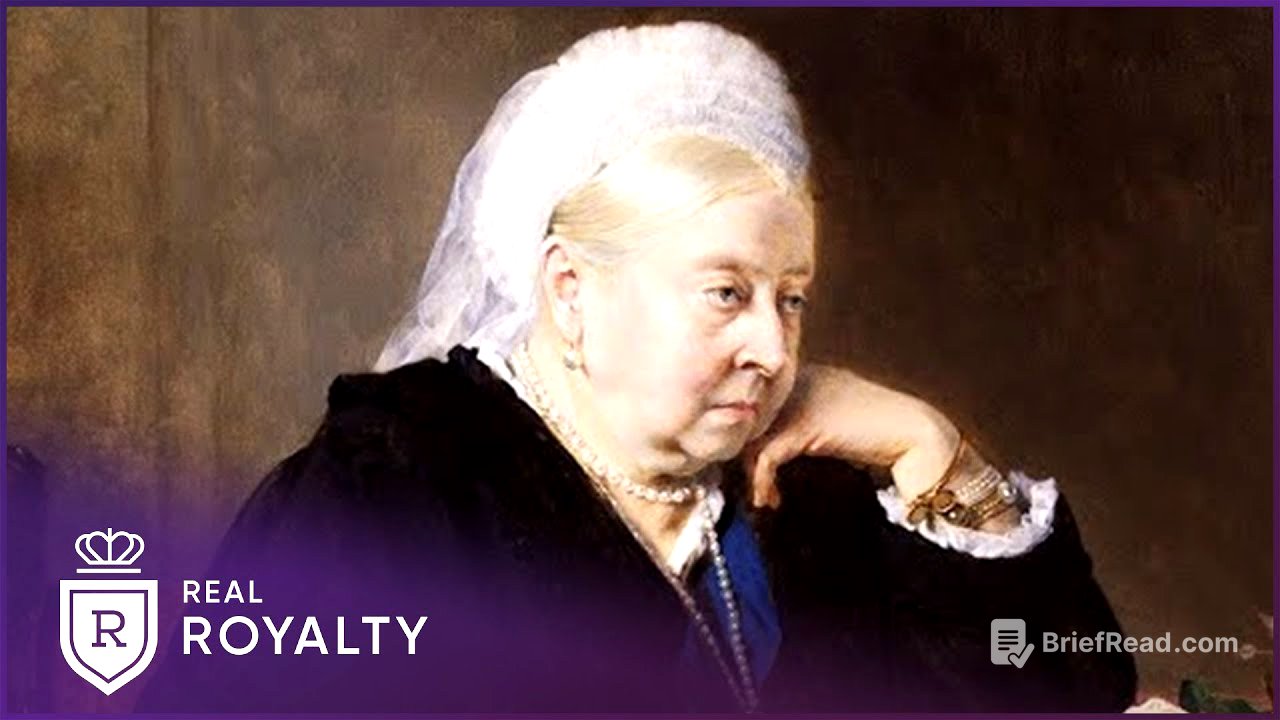TLDR;
This video explores the life of Queen Victoria beyond the conventional image of a grieving widow. It reveals how, after the deaths of her husband Albert and her mother, Victoria found liberation and exerted her political power, particularly in Germany. The video also examines her close relationships with John Brown and Abdul Karim, her complex relationship with Prime Ministers Gladstone and Disraeli, and her role as Empress of India. It highlights her unconventional nature, sense of humour, and the attempts by her children to censor her life story.
- Victoria's life after Albert's death was marked by newfound freedom and political influence.
- Her relationships with John Brown and Abdul Karim challenged social norms and provided her with companionship.
- Her interactions with Gladstone and Disraeli reveal her strong will and political acumen.
- Despite attempts to censor her life, Victoria's words and actions offer a fascinating insight into her unconventional character.
Introduction: Victoria's Diamond Jubilee and Public Image [0:03]
In 1897, Queen Victoria's Diamond Jubilee was a display of British confidence, but her public appearances were remarkable due to her long-standing mourning and shyness. While known as the "Widow of Windsor," this image only partially captures Victoria's complex character. The death of her husband and mother, though devastating, also initiated a liberation for Victoria, who had spent much of her life under the control of domineering men. As a child, she was a political pawn, and as a young queen, Prince Albert used her pregnancies to gain power. However, in her widowhood, Victoria was free to pursue her own path, documented extensively in her journals and letters, some of which were destroyed by her children due to their shocking content.
Victoria's Annus Horribilis and Initial Steps to Freedom [2:30]
The year 1861 marked a turning point for Queen Victoria with the deaths of her mother and Prince Albert, leading to a period of intense grief and withdrawal from public life. She described Albert as her "lover, friend, and crutch," highlighting her deep dependence on him. However, his death also inadvertently freed her from the constraints of their marriage, which had infantilised her. Gradually, Victoria began to assert her independence, starting with visits to Coburg, Germany, the birthplace of Albert and her mother, where she felt a strong connection to her German heritage.
Victoria's German Roots and Political Involvement [4:11]
Victoria's strong affinity for Germany, where she was three-quarters German, led her to frequently visit Coburg after Albert's death. She preferred staying at Schloss Rosenau, Albert's birthplace, finding solace in the familiar surroundings. Despite her grief, Victoria became politically active in Germany, which was then a collection of small states. In 1863, she intervened in the conflict between Prussia and Austria, advocating for a peaceful federation rather than Prussian dominance. This demonstrated her independent political influence, even as the British public perceived her as withdrawn and inactive.
Victoria's Relationship with John Brown [12:10]
Following Prince Albert's death, John Brown, a Highland servant from Balmoral, became an important figure in Queen Victoria's life, offering her companionship and support. Brown's down-to-earth nature and disregard for court etiquette provided a refreshing contrast to the stuffiness of royal life. He understood her loneliness and helped her to overcome her depression, becoming her closest confidant. Brown's unwavering devotion and service to the Queen were even greater than Albert's, although rumours of a romantic relationship circulated due to their closeness.
Victoria's Published Journals and the Scandalous Rumours [18:37]
Queen Victoria defied convention by publishing extracts from her private diaries in 1868, titled "Leaves from the Journal of Our Life in the Highlands," which became an instant bestseller. The journals chronicled her outdoor activities and life in Scotland, with John Brown prominently featured. This caused a scandal, with rumours of a romantic relationship between Victoria and Brown intensifying. A scurrilous pamphlet titled "John Brown's Legs" appeared, mocking their relationship. Despite the controversy, Victoria continued to favour Brown, leading to further disapproval from her family and politicians.
Theories and Intimacy with John Brown [23:44]
The nature of Queen Victoria's relationship with John Brown has been a subject of much speculation. While rumours of a secret marriage or love child circulated, it is more likely that they shared a tactile, loving relationship without being lovers in the traditional sense. Sir James Reid, Victoria's doctor, documented instances of their physical intimacy and playful interactions. Despite the lack of concrete evidence, their bond was undeniably close, providing Victoria with much-needed companionship and support.
Victoria's Dislike of Gladstone [27:15]
Queen Victoria had a strong dislike for her Liberal Prime Minister, William Gladstone, viewing him as arrogant, tyrannical, and lacking in understanding of the world. She used her influence and even her health to resist his policies, demonstrating her self-assertive nature. Gladstone, in turn, struggled to connect with the Queen, leading to frequent clashes and disagreements. Their strained relationship was evident in incidents such as the opening of the Blackfriars Bridge, which Victoria initially refused to attend.
Victoria's Relationship with Disraeli and Becoming Empress of India [35:03]
In contrast to her difficult relationship with Gladstone, Queen Victoria greatly admired Benjamin Disraeli, whose one-nation Toryism aligned with her political views. Disraeli knew how to make her laugh and provided her with the attention and flattery she craved. He treated her as an equal, confiding in her and making her feel valued. Disraeli's political skill and charm were evident in his unconventional visit to Hughenden Manor, where he welcomed her with elaborate gestures. In 1877, Disraeli announced Victoria as the Empress of India, a title that delighted her and solidified Britain's imperial power.
The Deaths of Disraeli and Brown [41:37]
The political romance between Queen Victoria and Benjamin Disraeli ended with his death, leaving her distraught. She confessed that his loss was more heavily felt than any other, including her daughter Alice and Prince Albert. Just two years later, the death of John Brown further devastated Victoria, leaving her alone once again. Despite these losses, Victoria continued to carry on, demonstrating remarkable fortitude and reinventing herself in the face of grief.
Victoria's Golden Jubilee and Abdul Karim [43:33]
Queen Victoria's Golden Jubilee in 1887 was a grand celebration of her reign, with crowds lining the streets of London. In her Jubilee year, she developed a close relationship with Abdul Karim, a young Indian servant who became her Indian teacher and confidant. Victoria was fascinated by India and its culture, and Abdul Karim provided her with insights into the lives of ordinary Indians. Their relationship, however, caused resentment among the English courtiers, who viewed him with suspicion and racism.
Controversies Surrounding Abdul Karim [48:06]
Queen Victoria's fondness for Abdul Karim led to controversies and unrest within the court. She promoted him to the position of Munshi, her Indian teacher, and showered him with favours, including John Brown's old room and his own carriage. The courtiers resented Abdul Karim's influence and accused him of arrogance. An incident involving a stolen brooch further strained relations, with Victoria defending Abdul Karim's brother-in-law and criticising the English sense of justice.
The Climax of Tensions in Nice [51:58]
Tensions reached a climax during Queen Victoria's trip to Nice in 1897, when the courtiers threatened to resign if Abdul Karim accompanied her. Dr. Reid's revelation that Abdul Karim had contracted gonorrhoea was used as an excuse to exclude him from the trip. However, Victoria refused to yield, leading to a screaming rage and a victory for both the Queen and Abdul Karim. When a local newspaper described Abdul Karim as a mere servant, Victoria insisted on a retraction, asserting his status as her Indian secretary and a gentleman in her suite.
Victoria's Legacy and Unconventional Attachments [54:37]
Queen Victoria's legacy extends beyond her role as a monarch; she was a woman who defied social constraints and found freedom in unconventional relationships. Despite living a life often shielded from the public eye, she emerged as an icon of British power. Upon her death in 1901, Victoria requested to be buried with mementos of her favourite people, including a photograph of John Brown and a ring he had given her. However, her children censored her life, destroying statues and burning letters in an attempt to erase her unconventional attachments from history. Despite these efforts, Victoria's words and actions continue to provide a fascinating insight into her extraordinary human being.









